engine oil YAMAHA WR 450F 2016 Owners Manual
[x] Cancel search | Manufacturer: YAMAHA, Model Year: 2016, Model line: WR 450F, Model: YAMAHA WR 450F 2016Pages: 426, PDF Size: 10.86 MB
Page 9 of 426
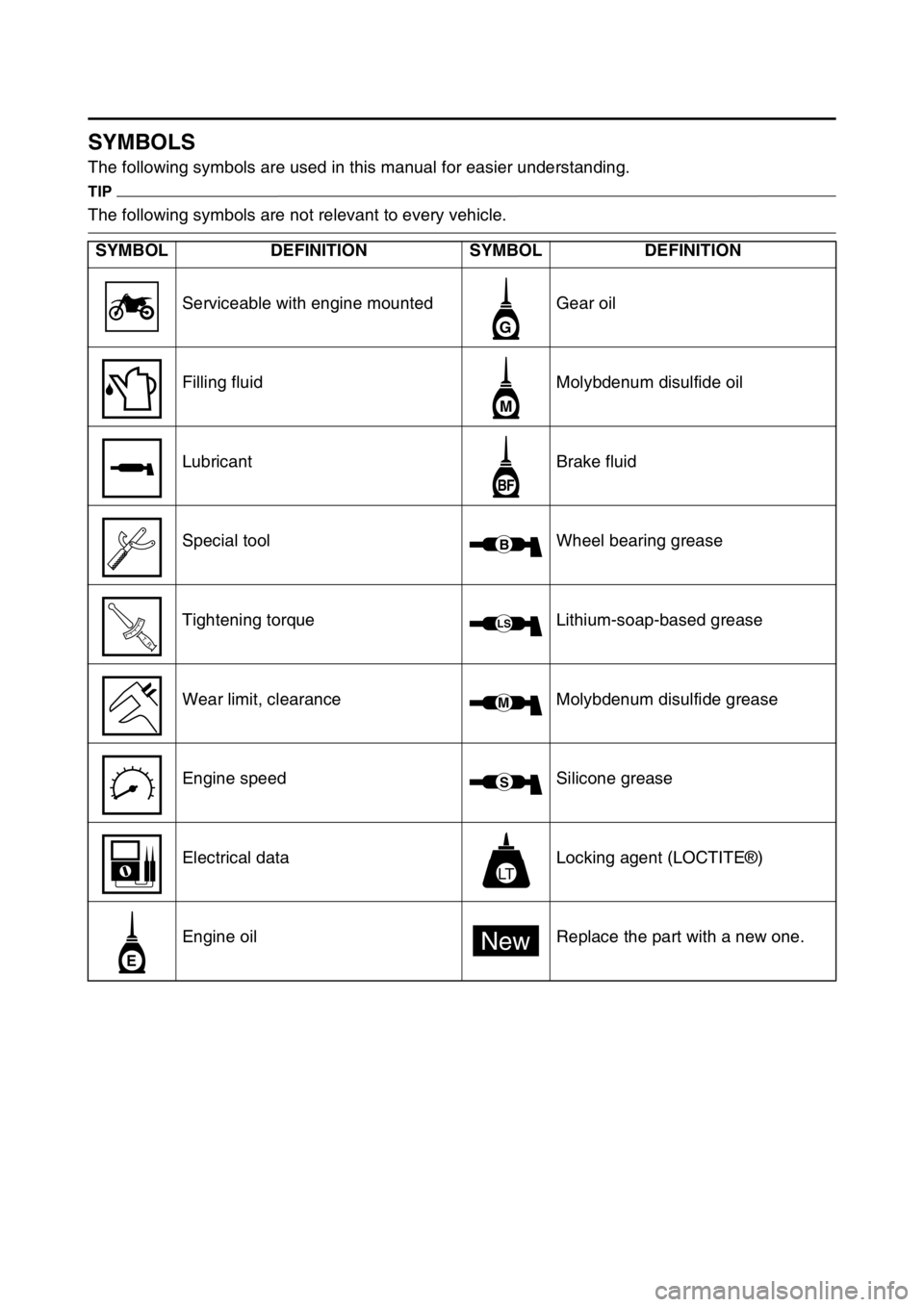
EAS2GC1007
SYMBOLS
The following symbols are used in this manual for easier understanding.
TIP
The following symbols are not relevant to every vehicle.
SYMBOL DEFINITION SYMBOL DEFINITION
Serviceable with engine mounted Gear oil
Filling fluid Molybdenum disulfide oil
Lubricant Brake fluid
Special tool Wheel bearing grease
Tightening torque Lithium-soap-based grease
Wear limit, clearance Molybdenum disulfide grease
Engine speed Silicone grease
Electrical data Locking agent (LOCTITE®)
Engine oil Replace the part with a new one.
G
M
BF
B
T R..
LS
M
S
LT
E
New
Page 13 of 426

1
GENERAL INFORMATION
LOCATION OF IMPORTANT LABELS............................................................ 1-1
DESCRIPTION .................................................................................................. 1-4
IDENTIFICATION ............................................................................................. 1-5
VEHICLE IDENTIFICATION NUMBER ...................................................... 1-5
ENGINE SERIAL NUMBER ....................................................................... 1-5
VEHICLE EMISSION CONTROL INFORMATION LABEL......................... 1-5
INCLUDED PARTS .......................................................................................... 1-6
SPARK PLUG WRENCH ........................................................................... 1-6
NIPPLE WRENCH...................................................................................... 1-6
HANDLEBAR PROTECTOR .. .................................................................... 1-6
FUEL HOSE JOINT COVER ...................................................................... 1-6
COUPLER FOR CONNECTING OPTIONAL PART................................... 1-6
IMPORTANT INFORMATION .......................................................................... 1-7
PREPARATION FOR REMOVAL A ND DISASSEMBLY............................ 1-7
REPLACEMENT PARTS............................................................................ 1-7
GASKETS, OIL SEALS AND O-RINGS ..................................................... 1-8
LOCK WASHERS/PLATES AND COTTER PINS ...................................... 1-8
BEARINGS AND OIL SEALS ..................................................................... 1-8
CIRCLIPS ................................................................................................... 1-8
BASIC SERVICE INFORMATION .................................................................... 1-9
ELECTRICAL SYSTEM.......... .................................................................... 1-9
SPECIAL TOOLS ........................................................................................... 1-13
CONTROL FUNCTIONS ................................................................................ 1-18
INDICATOR LIGHTS AND WARNING LIGHTS ....................................... 1-18
ENGINE STOP SWITCH .......................................................................... 1-18
START SWITCH....................................................................................... 1-18
CLUTCH LEVER ................................................................................... ... 1-18
SHIFT PEDAL .......................................................................................... 1-19
KICKSTARTER LEVER.......... .................................................................. 1-19
THROTTLE GRIP ..................................................................................... 1-19
FRONT BRAKE LEVER ........................................................................... 1-19
REAR BRAKE PEDAL.............................................................................. 1-19
SIDESTAND ............................................................................................. 1-20
STARTER KNOB/IDLE SCREW .............................................................. 1-20
FUEL TANK CAP ..................................................................................... 1-20
Page 18 of 426
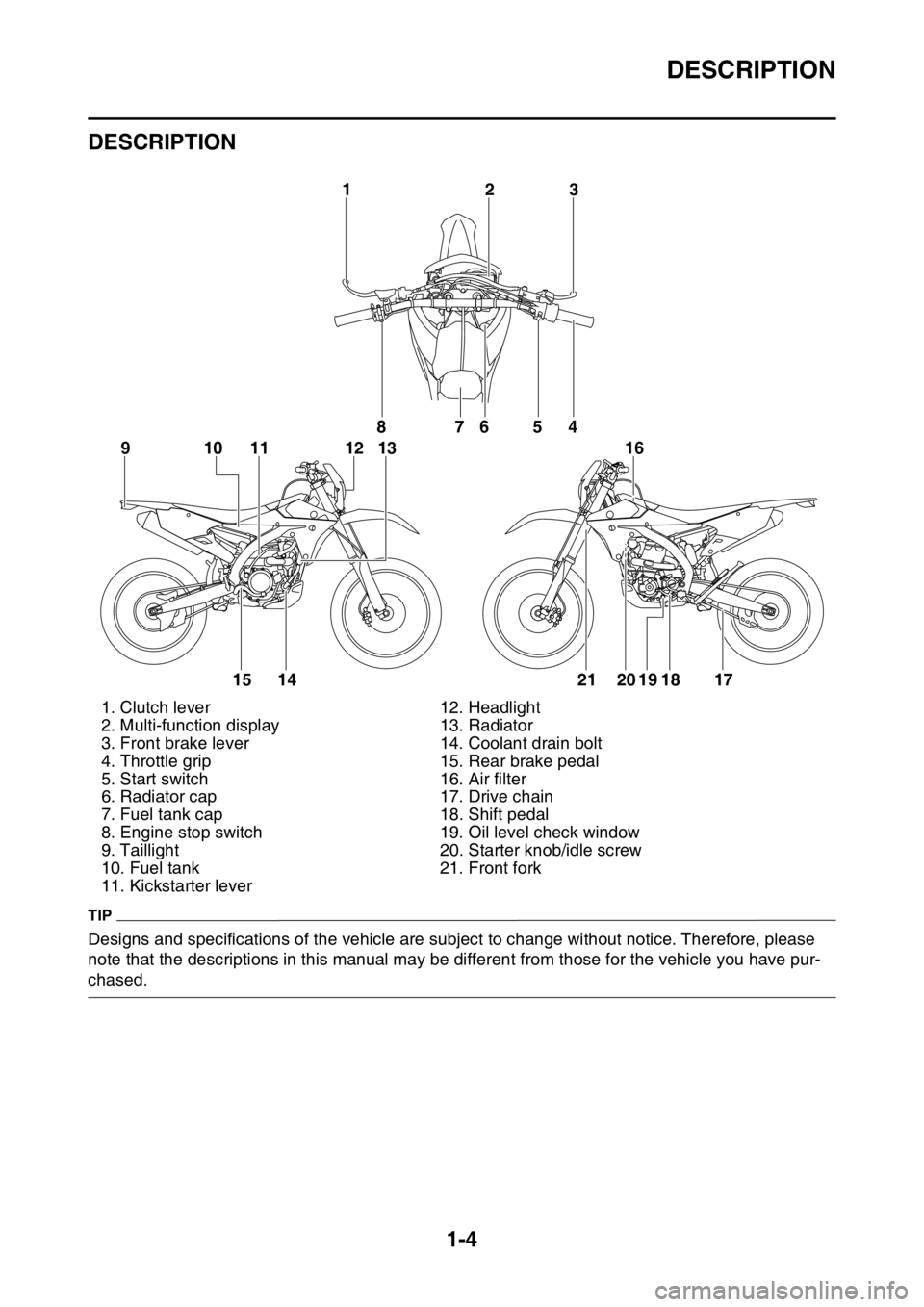
DESCRIPTION
1-4
EAS2GC1009
DESCRIPTION
TIP
Designs and specifications of the vehicle are subject to change without notice. Therefore, please
note that the descriptions in this manual may be different from those for the vehicle you have pur-
chased.1. Clutch lever 12. Headlight
2. Multi-function display 13. Radiator
3. Front brake lever 14. Coolant drain bolt
4. Throttle grip 15. Rear brake pedal
5. Start switch 16. Air filter
6. Radiator cap 17. Drive chain
7. Fuel tank cap 18. Shift pedal
8. Engine stop switch 19. Oil level check window
9. Taillight 20. Starter knob/idle screw
10. Fuel tank 21. Front fork
11. Kickstarter lever
32
1
8
10
91 112 1376
54
15 14 21 20 19 18 17 16
Page 21 of 426
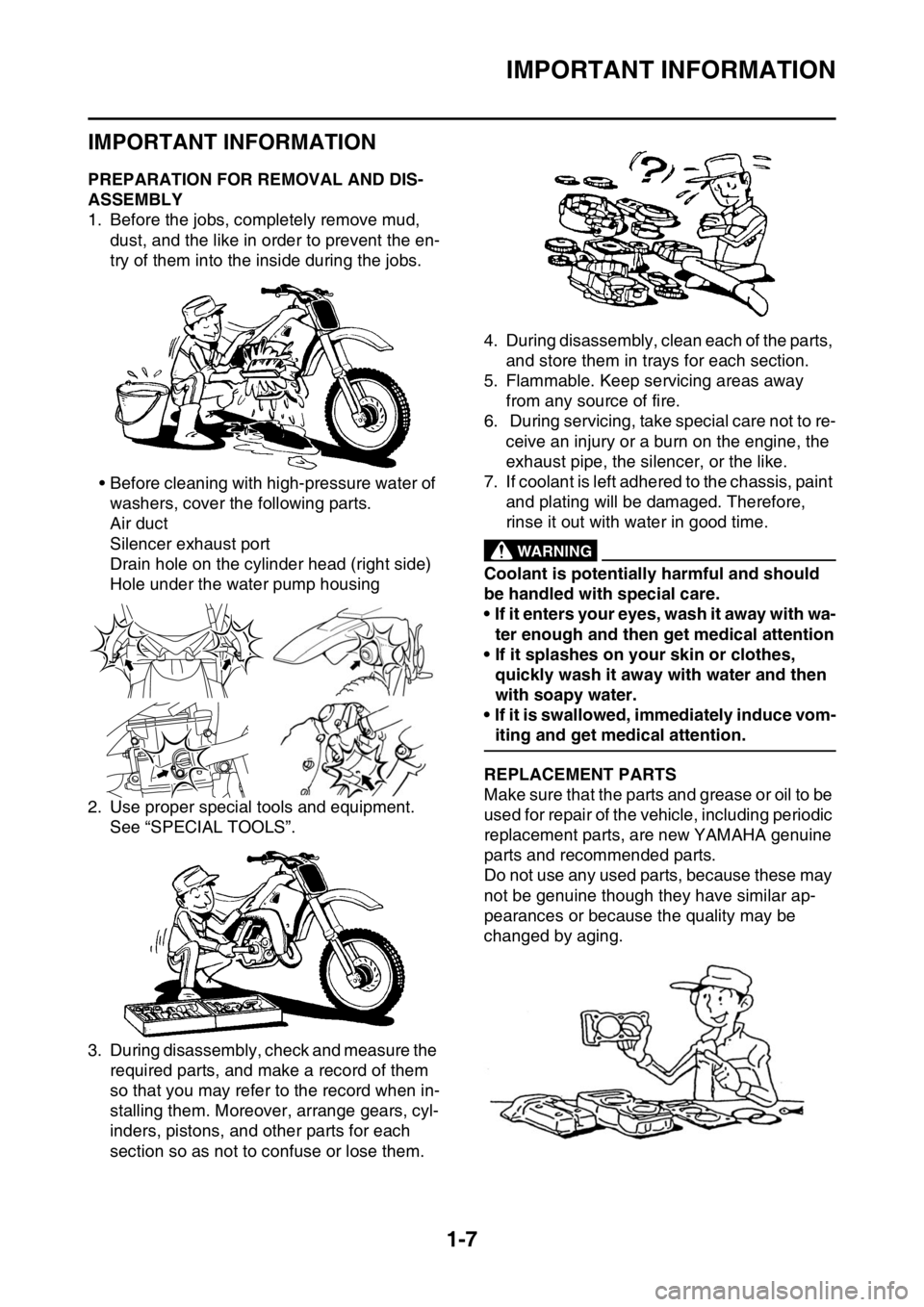
IMPORTANT INFORMATION
1-7
EAS20180
IMPORTANT INFORMATION
EAS2GC1020PREPARATION FOR REMOVAL AND DIS-
ASSEMBLY
1. Before the jobs, completely remove mud, dust, and the like in order to prevent the en-
try of them into the inside during the jobs.
• Before cleaning with high-pressure water of washers, cover the following parts.
Air duct
Silencer exhaust port
Drain hole on the cylinder head (right side)
Hole under the water pump housing
2. Use proper special tools and equipment. See “SPECIAL TOOLS”.
3. During disassembly, check and measure the required parts, and make a record of them
so that you may refer to the record when in-
stalling them. Moreover, arrange gears, cyl-
inders, pistons, and other parts for each
section so as not to confuse or lose them. 4. During disassembly, clean each of the parts,
and store them in trays for each section.
5. Flammable. Keep servicing areas away from any source of fire.
6. During servicing, take special care not to re-
ceive an injury or a burn on the engine, the
exhaust pipe, the silencer, or the like.
7. If coolant is left adhered to the chassis, paint
and plating will be damaged. Therefore,
rinse it out with water in good time.
EWA
WARNING
Coolant is potentially harmful and should
be handled with special care.
• If it enters your eyes, wash it away with wa-ter enough and then get medical attention
• If it splashes on your skin or clothes,
quickly wash it away with water and then
with soapy water.
• If it is swallowed, immediately induce vom-
iting and get medical attention.
EAS2GC1021REPLACEMENT PARTS
Make sure that the parts and grease or oil to be
used for repair of the vehicle, including periodic
replacement parts, are new YAMAHA genuine
parts and recommended parts.
Do not use any used parts, because these may
not be genuine though they have similar ap-
pearances or because the quality may be
changed by aging.
Page 22 of 426
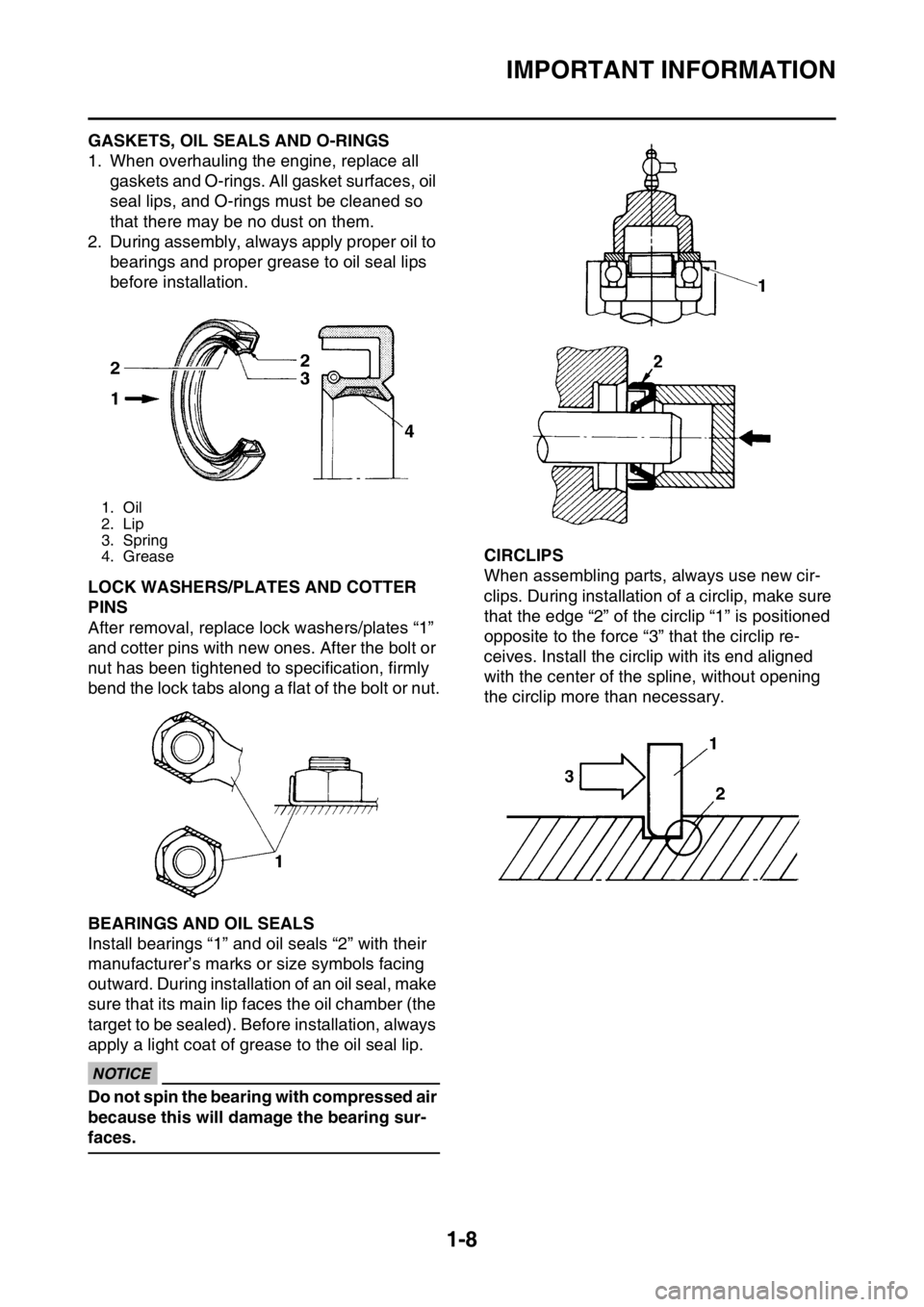
IMPORTANT INFORMATION
1-8
EAS2GC1022GASKETS, OIL SEALS AND O-RINGS
1. When overhauling the engine, replace all gaskets and O-rings. All gasket surfaces, oil
seal lips, and O-rings must be cleaned so
that there may be no dust on them.
2. During assembly, always apply proper oil to bearings and proper grease to oil seal lips
before installation.
EAS2GC1023LOCK WASHERS/PLATES AND COTTER
PINS
After removal, replace lock washers/plates “1”
and cotter pins with new ones. After the bolt or
nut has been tightened to specification, firmly
bend the lock tabs along a flat of the bolt or nut.
EAS2GC1024BEARINGS AND OIL SEALS
Install bearings “1” and oil seals “2” with their
manufacturer’s marks or size symbols facing
outward. During installation of an oil seal, make
sure that its main lip faces the oil chamber (the
target to be sealed). Before installation, always
apply a light coat of grease to the oil seal lip.
ECA
NOTICE
Do not spin the bearing with compressed air
because this will damage the bearing sur-
faces.
EAS2GC1025CIRCLIPS
When assembling parts, always use new cir-
clips. During installation of a circlip, make sure
that the edge “2” of the circlip “1” is positioned
opposite to the force “3” that the circlip re-
ceives. Install the circ lip with its end aligned
with the center of the spline, without opening
the circlip more than necessary.
1. Oil
2. Lip
3. Spring
4. Grease
Page 31 of 426

SPECIAL TOOLS
1-17
Valve spring compressor at-
tachment
90890-04108
Valve spring compressor
adapter 22 mm
YM-04108This tool is used to discon-
nect or connect the valve and
the valve spring.
Rotor puller
90890-04142
Rotor puller
YM-04142 This tool is used to remove
the rotor.
Crankcase separating tool
90890-04152
Crankcase separating tool
YU-A9642 This tool is used to remove
the crankshaft.
Ignition checker
90890-06754
Oppama pet–4000 spark
checker
YM-34487 This tool is used to check the
spark performance of the ig-
nition coil.
Digital tachometer
90890-06760
Digital tachometer
YU-39951-B This tool is used to measure
the engine speed.
Yamaha bond No. 1215
90890-85505
(Three bond No.1215®) This sealant (Bond) is used
for crankcase mating sur-
face, etc.
Tool name/Part number How to use Illustration
Page 42 of 426
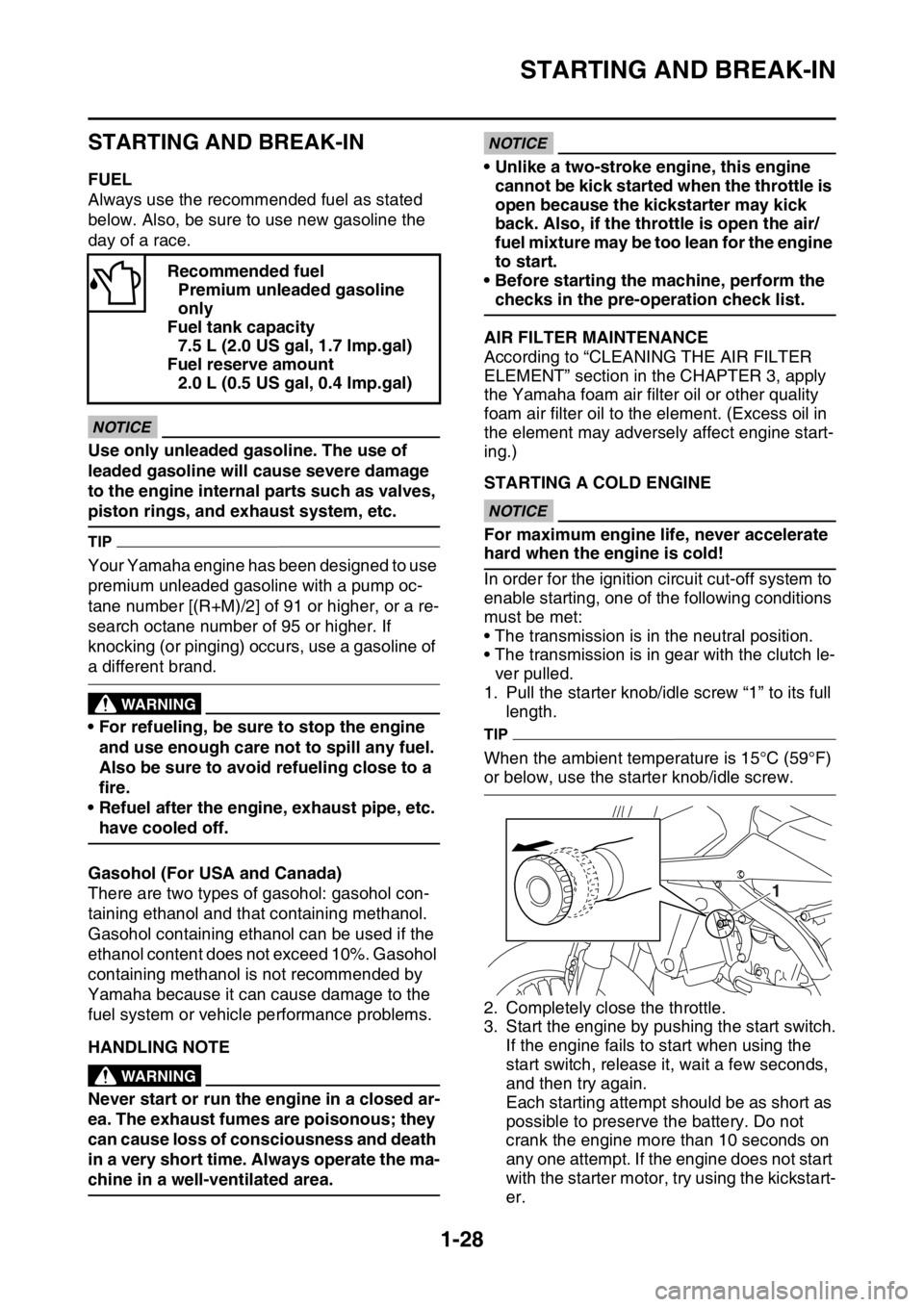
STARTING AND BREAK-IN
1-28
EAS2GC1048
STARTING AND BREAK-IN
EAS2GC1049FUEL
Always use the recommended fuel as stated
below. Also, be sure to use new gasoline the
day of a race.
ECA
NOTICE
Use only unleaded gasoline. The use of
leaded gasoline will cause severe damage
to the engine internal parts such as valves,
piston rings, and exhaust system, etc.
TIP
Your Yamaha engine has been designed to use
premium unleaded gasoline with a pump oc-
tane number [(R+M)/2] of 91 or higher, or a re-
search octane number of 95 or higher. If
knocking (or pinging) occurs, use a gasoline of
a different brand.
EWA
WARNING
• For refueling, be sure to stop the engine and use enough care not to spill any fuel.
Also be sure to avoid refueling close to a
fire.
• Refuel after the engine, exhaust pipe, etc.
have cooled off.
Gasohol (For USA and Canada)
There are two types of gasohol: gasohol con-
taining ethanol and that containing methanol.
Gasohol containing ethanol can be used if the
ethanol content does not exceed 10%. Gasohol
containing methanol is not recommended by
Yamaha because it can cause damage to the
fuel system or vehicle performance problems.
EAS2GC1050HANDLING NOTEEWA
WARNING
Never start or run the engine in a closed ar-
ea. The exhaust fumes are poisonous; they
can cause loss of consciousness and death
in a very short time. Always operate the ma-
chine in a well-ventilated area.
ECA
NOTICE
• Unlike a two-stroke engine, this engine cannot be kick started when the throttle is
open because the kickstarter may kick
back. Also, if the throttle is open the air/
fuel mixture may be too lean for the engine
to start.
• Before starting the machine, perform the
checks in the pre-operation check list.
EAS2GC1051AIR FILTER MAINTENANCE
According to “CLEANING THE AIR FILTER
ELEMENT” section in the CHAPTER 3, apply
the Yamaha foam air filter oil or other quality
foam air filter oil to the element. (Excess oil in
the element may adversely affect engine start-
ing.)
EAS2GC1052STARTING A COLD ENGINEECA
NOTICE
For maximum engine life, never accelerate
hard when the engine is cold!
In order for the ignition circuit cut-off system to
enable starting, one of the following conditions
must be met:
• The transmission is in the neutral position.
• The transmission is in gear with the clutch le- ver pulled.
1. Pull the starter knob/idle screw “1” to its full length.
TIP
When the ambient temperature is 15°C (59°F)
or below, use the starter knob/idle screw.
2. Completely close the throttle.
3. Start the engine by pushing the start switch.If the engine fails to start when using the
start switch, release it, wait a few seconds,
and then try again.
Each starting attempt should be as short as
possible to preserve the battery. Do not
crank the engine more than 10 seconds on
any one attempt. If the engine does not start
with the starter motor, try using the kickstart-
er.
Recommended fuel
Premium unleaded gasoline
only
Fuel tank capacity 7.5 L (2.0 US gal, 1.7 lmp.gal)
Fuel reserve amount 2.0 L (0.5 US gal, 0.4 Imp.gal)
1
Page 44 of 426
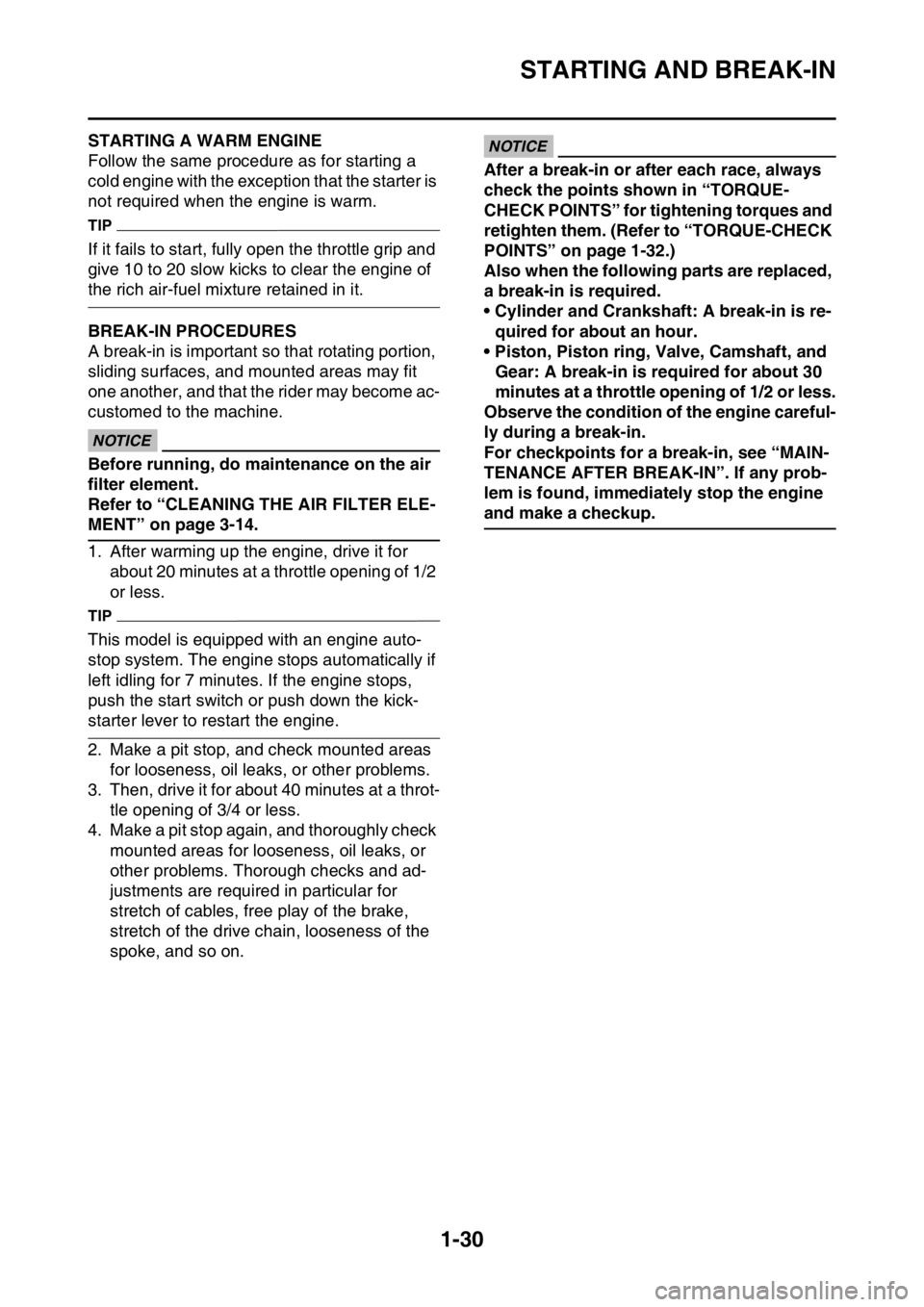
STARTING AND BREAK-IN
1-30
EAS2GC1053STARTING A WARM ENGINE
Follow the same procedure as for starting a
cold engine with the exception that the starter is
not required when the engine is warm.
TIP
If it fails to start, fully open the throttle grip and
give 10 to 20 slow kicks to clear the engine of
the rich air-fuel mixture retained in it.
EAS2GC1054BREAK-IN PROCEDURES
A break-in is important so that rotating portion,
sliding surfaces, and mounted areas may fit
one another, and that the rider may become ac-
customed to the machine.
ECA
NOTICE
Before running, do maintenance on the air
filter element.
Refer to “CLEANING THE AIR FILTER ELE-
MENT” on page 3-14.
1. After warming up the engine, drive it for about 20 minutes at a throttle opening of 1/2
or less.
TIP
This model is equipped with an engine auto-
stop system. The engine stops automatically if
left idling for 7 minutes. If the engine stops,
push the start switch or push down the kick-
starter lever to restart the engine.
2. Make a pit stop, and check mounted areas
for looseness, oil leaks, or other problems.
3. Then, drive it for about 40 minutes at a throt- tle opening of 3/4 or less.
4. Make a pit stop again, and thoroughly check mounted areas for looseness, oil leaks, or
other problems. Thorough checks and ad-
justments are required in particular for
stretch of cables, free play of the brake,
stretch of the drive chain, looseness of the
spoke, and so on.
ECA
NOTICE
After a break-in or after each race, always
check the points shown in “TORQUE-
CHECK POINTS” for tightening torques and
retighten them. (Refer to “TORQUE-CHECK
POINTS” on page 1-32.)
Also when the following parts are replaced,
a break-in is required.
• Cylinder and Crankshaft: A break-in is re-quired for about an hour.
• Piston, Piston ring, Valve, Camshaft, and
Gear: A break-in is required for about 30
minutes at a throttle opening of 1/2 or less.
Observe the condition of the engine careful-
ly during a break-in.
For checkpoints for a break-in, see “MAIN-
TENANCE AFTER BREAK-IN”. If any prob-
lem is found, immediately stop the engine
and make a checkup.
Page 45 of 426
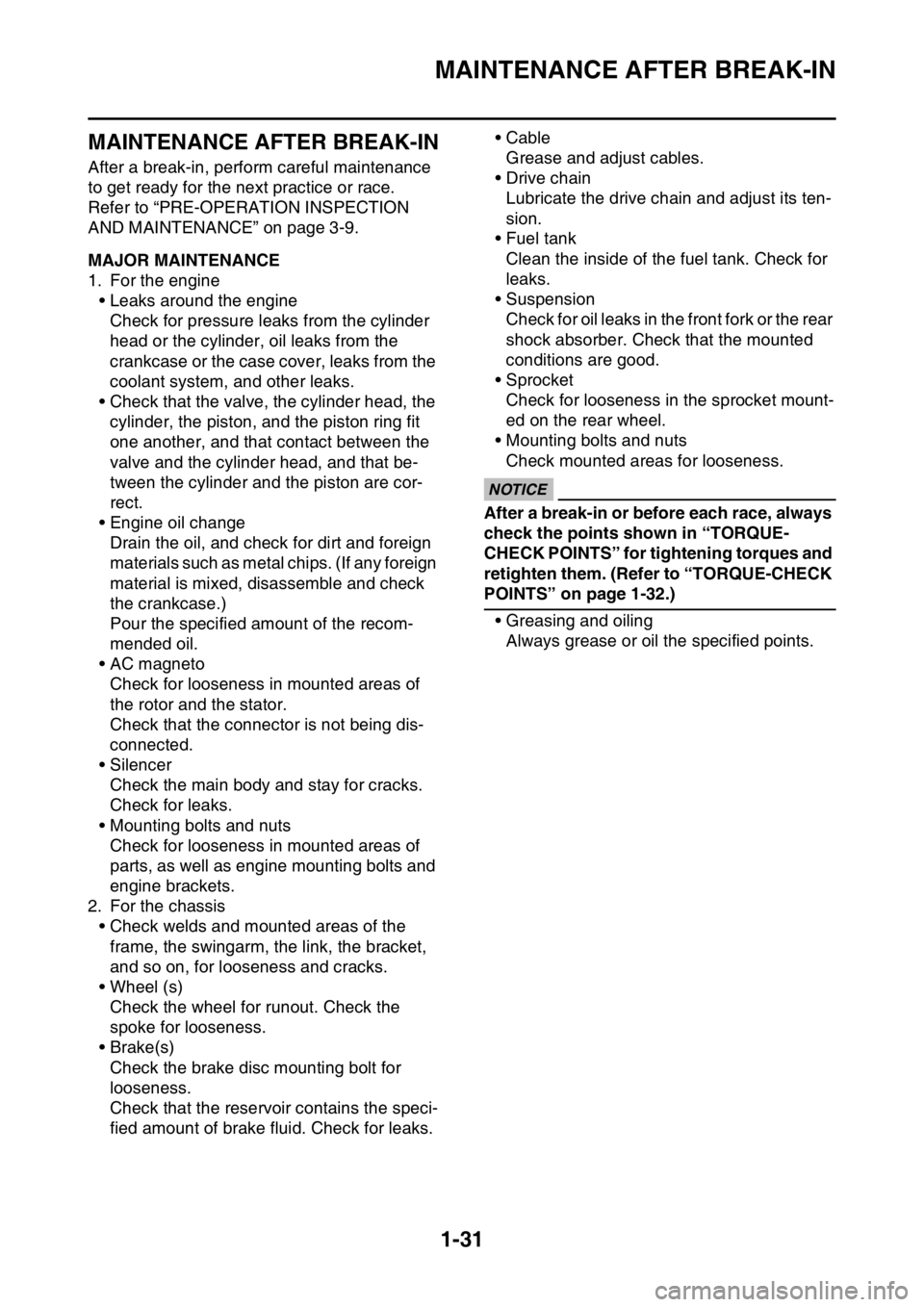
MAINTENANCE AFTER BREAK-IN
1-31
EAS2GC1055
MAINTENANCE AFTER BREAK-IN
After a break-in, perform careful maintenance
to get ready for the next practice or race.
Refer to “PRE-OPERATION INSPECTION
AND MAINTENANCE” on page 3-9.
EAS2GC1056MAJOR MAINTENANCE
1. For the engine• Leaks around the engineCheck for pressure l eaks from the cylinder
head or the cylinder, oil leaks from the
crankcase or the case cover, leaks from the
coolant system, and other leaks.
• Check that the valve, the cylinder head, the cylinder, the piston, and the piston ring fit
one another, and that contact between the
valve and the cylinder head, and that be-
tween the cylinder and the piston are cor-
rect.
• Engine oil change Drain the oil, and check for dirt and foreign
materials such as metal chips. (If any foreign
material is mixed, disassemble and check
the crankcase.)
Pour the specified amount of the recom-
mended oil.
• AC magneto
Check for looseness in mounted areas of
the rotor and the stator.
Check that the connector is not being dis-
connected.
• Silencer Check the main body and stay for cracks.
Check for leaks.
• Mounting bolts and nuts Check for looseness in mounted areas of
parts, as well as engine mounting bolts and
engine brackets.
2. For the chassis
• Check welds and mounted areas of the frame, the swingarm, the link, the bracket,
and so on, for looseness and cracks.
• Wheel (s) Check the wheel for runout. Check the
spoke for looseness.
• Brake(s) Check the brake disc mounting bolt for
looseness.
Check that the reservoir contains the speci-
fied amount of brake fluid. Check for leaks. • Cable
Grease and adjust cables.
•Drive chain
Lubricate the drive chain and adjust its ten-
sion.
• Fuel tank
Clean the inside of the fuel tank. Check for
leaks.
• Suspension
Check for oil leaks in the front fork or the rear
shock absorber. Check that the mounted
conditions are good.
• Sprocket Check for looseness in the sprocket mount-
ed on the rear wheel.
• Mounting bolts and nuts
Check mounted areas for looseness.
ECA
NOTICE
After a break-in or before each race, always
check the points shown in “TORQUE-
CHECK POINTS” for tightening torques and
retighten them. (Refer to “TORQUE-CHECK
POINTS” on page 1-32.)
• Greasing and oilingAlways grease or oil the specified points.
Page 48 of 426
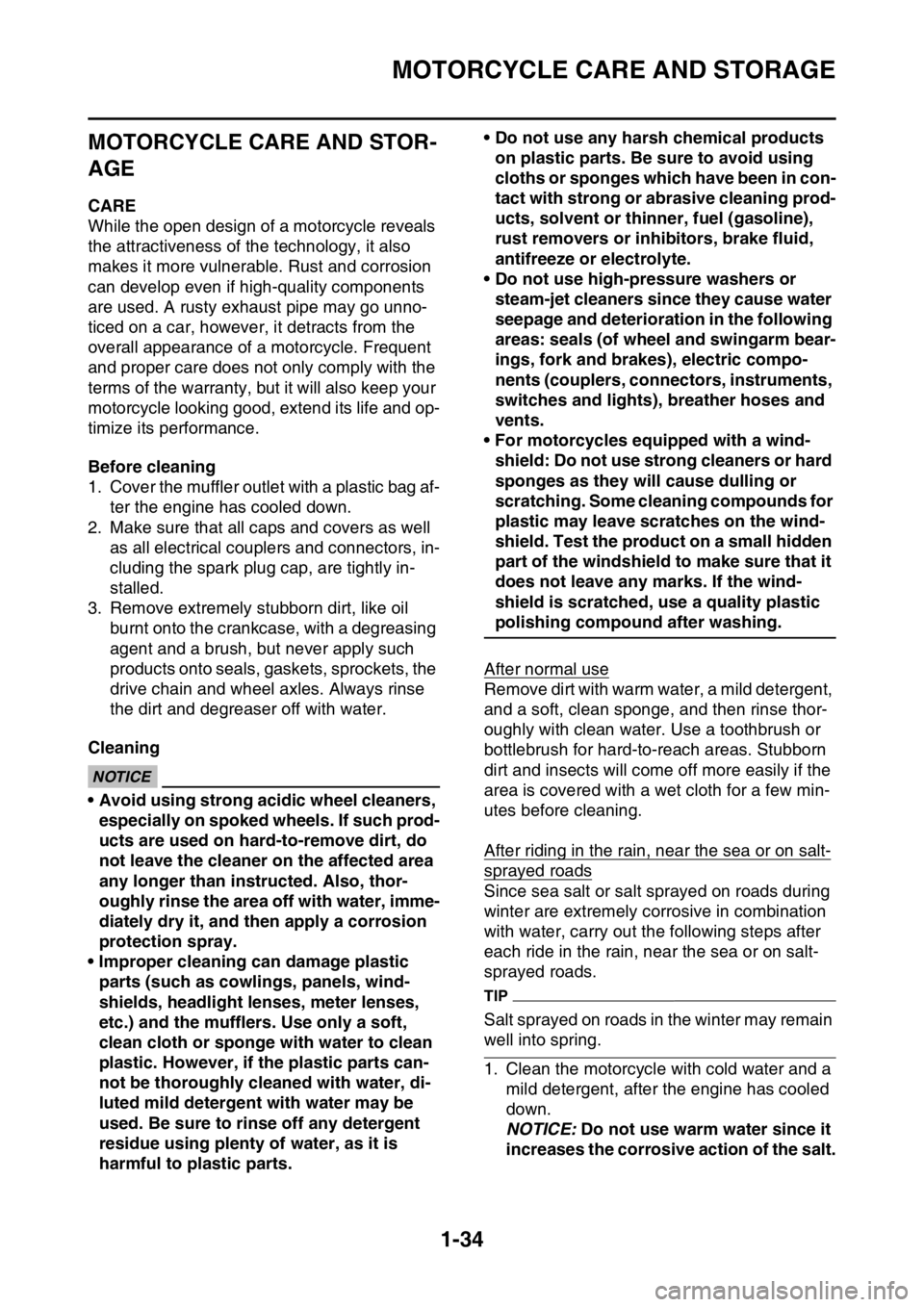
MOTORCYCLE CARE AND STORAGE
1-34
EAS2GC1058
MOTORCYCLE CARE AND STOR-
AGE
EAS2GC1059CARE
While the open design of a motorcycle reveals
the attractiveness of the technology, it also
makes it more vulnerable. Rust and corrosion
can develop even if high-quality components
are used. A rusty exhaust pipe may go unno-
ticed on a car, however, it detracts from the
overall appearance of a motorcycle. Frequent
and proper care does not only comply with the
terms of the warranty, but it will also keep your
motorcycle looking good, extend its life and op-
timize its performance.
Before cleaning
1. Cover the muffler outlet with a plastic bag af-ter the engine has cooled down.
2. Make sure that all caps and covers as well as all electrical coup lers and connectors, in-
cluding the spark plug cap, are tightly in-
stalled.
3. Remove extremely stubborn dirt, like oil
burnt onto the crankcase, with a degreasing
agent and a brush, but never apply such
products onto seals, gaskets, sprockets, the
drive chain and wheel axles. Always rinse
the dirt and degreaser off with water.
Cleaning
ECA
NOTICE
• Avoid using strong acidic wheel cleaners, especially on spoked wheels. If such prod-
ucts are used on hard-to-remove dirt, do
not leave the cleaner on the affected area
any longer than instructed. Also, thor-
oughly rinse the area off with water, imme-
diately dry it, and then apply a corrosion
protection spray.
• Improper cleaning can damage plastic parts (such as cowlings, panels, wind-
shields, headlight lenses, meter lenses,
etc.) and the mufflers. Use only a soft,
clean cloth or sponge with water to clean
plastic. However, if the plastic parts can-
not be thoroughly cleaned with water, di-
luted mild detergent with water may be
used. Be sure to rinse off any detergent
residue using plenty of water, as it is
harmful to plastic parts. • Do not use any harsh chemical products
on plastic parts. Be sure to avoid using
cloths or sponges which have been in con-
tact with strong or abrasive cleaning prod-
ucts, solvent or thinner, fuel (gasoline),
rust removers or inhibitors, brake fluid,
antifreeze or electrolyte.
• Do not use high-pressure washers or steam-jet cleaners since they cause water
seepage and deterioration in the following
areas: seals (of wheel and swingarm bear-
ings, fork and brakes), electric compo-
nents (couplers, connectors, instruments,
switches and lights), breather hoses and
vents.
• For motorcycles equipped with a wind-
shield: Do not use strong cleaners or hard
sponges as they will cause dulling or
scratching. Some cleaning compounds for
plastic may leave scratches on the wind-
shield. Test the product on a small hidden
part of the windshield to make sure that it
does not leave any marks. If the wind-
shield is scratched, use a quality plastic
polishing compound after washing.
After normal use
Remove dirt with warm water, a mild detergent,
and a soft, clean sponge, and then rinse thor-
oughly with clean water. Use a toothbrush or
bottlebrush for hard-to-reach areas. Stubborn
dirt and insects will come off more easily if the
area is covered with a wet cloth for a few min-
utes before cleaning.
After riding in the rain, near the sea or on salt-
sprayed roads
Since sea salt or salt sprayed on roads during
winter are extremely corrosive in combination
with water, carry out the following steps after
each ride in the rain, near the sea or on salt-
sprayed roads.
TIP
Salt sprayed on roads in the winter may remain
well into spring.
1. Clean the motorcycle with cold water and a mild detergent, after the engine has cooled
down.
NOTICE: Do not use warm water since it
increases the corrosive action of the salt.